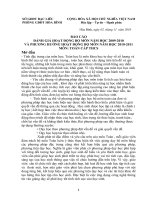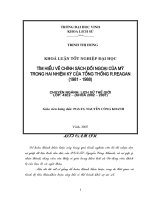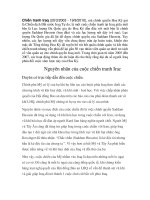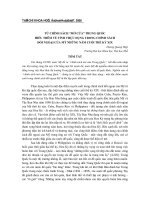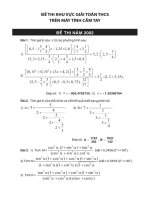picturing numbers grade 6 Bộ Sách Toán THCS Của Mỹ
Bạn đang xem bản rút gọn của tài liệu. Xem và tải ngay bản đầy đủ của tài liệu tại đây (3.76 MB, 56 trang )
Picturing
Numbers
Data Analysis and
Probability
CuuDuongThanCong.com
/>
Mathematics in Context is a comprehensive curriculum for the middle grades.
It was developed in 1991 through 1997 in collaboration with the Wisconsin Center
for Education Research, School of Education, University of Wisconsin-Madison and
the Freudenthal Institute at the University of Utrecht, The Netherlands, with the
support of the National Science Foundation Grant No. 9054928.
The revision of the curriculum was carried out in 2003 through 2005, with the
support of the National Science Foundation Grant No. ESI 0137414.
National Science Foundation
Opinions expressed are those of the authors
and not necessarily those of the Foundation.
Boswinkel, N., Niehaus, J., Gravemeijer, K., Wijers, M., Dekker, T., Middleton, J. A.,
Spence, M. S., Burrill, G., & Milinkovic, J. (2006). Picturing numbers. In Wisconsin
Center for Education Research & Freudenthal Institute (Eds.), Mathematics in
Context. Chicago: Encyclopædia Britannica, Inc.
Copyright © 2006 Encyclopædia Britannica, Inc.
All rights reserved.
Printed in the United States of America.
This work is protected under current U.S. copyright laws, and the performance,
display, and other applicable uses of it are governed by those laws. Any uses not
in conformity with the U.S. copyright statute are prohibited without our express
written permission, including but not limited to duplication, adaptation, and
transmission by television or other devices or processes. For more information
regarding a license, write Encyclopædia Britannica, Inc., 331 North LaSalle Street,
Chicago, Illinois 60610.
ISBN 0-03-042402-X
1 2 3 4 5 6 073 09 08 07 06 05
CuuDuongThanCong.com
/>
The Mathematics in Context Development Team
Development 1991–1997
The initial version of Picturing Numbers was developed by Nina Boswinkel, Jansie Niehaus,
and Koeno Gravemeijer. It was adapted for use in American schools by James A, Middleton,
Mary S. Spence, Gail Burrill, and Jasmina Milinkovic.
Wisconsin Center for Education
Freudenthal Institute Staff
Research Staff
Thomas A. Romberg
Joan Daniels Pedro
Jan de Lange
Director
Assistant to the Director
Director
Gail Burrill
Margaret R. Meyer
Els Feijs
Martin van Reeuwijk
Coordinator
Coordinator
Coordinator
Coordinator
Sherian Foster
James A, Middleton
Jasmina Milinkovic
Margaret A. Pligge
Mary C. Shafer
Julia A. Shew
Aaron N. Simon
Marvin Smith
Stephanie Z. Smith
Mary S. Spence
Mieke Abels
Jansie Niehaus
Nina Boswinkel
Nanda Querelle
Frans van Galen
Anton Roodhardt
Koeno Gravemeijer
Leen Streefland
Marja van den Heuvel-Panhuizen
Jan Auke de Jong
Adri Treffers
Vincent Jonker
Monica Wijers
Ronald Keijzer
Astrid de Wild
Martin Kindt
Project Staff
Jonathan Brendefur
Laura Brinker
James Browne
Jack Burrill
Rose Byrd
Peter Christiansen
Barbara Clarke
Doug Clarke
Beth R. Cole
Fae Dremock
Mary Ann Fix
Revision 2003–2005
The revised version of Picturing Numbers was developed by Monica Wijers and Truus Dekker.
It was adapted for use in American schools by Gail Burrill.
Wisconsin Center for Education
Freudenthal Institute Staff
Research Staff
Thomas A. Romberg
David C. Webb
Jan de Lange
Truus Dekker
Director
Coordinator
Director
Coordinator
Gail Burrill
Margaret A. Pligge
Mieke Abels
Monica Wijers
Editorial Coordinator
Editorial Coordinator
Content Coordinator
Content Coordinator
Margaret R. Meyer
Anne Park
Bryna Rappaport
Kathleen A. Steele
Ana C. Stephens
Candace Ulmer
Jill Vettrus
Arthur Bakker
Peter Boon
Els Feijs
Dédé de Haan
Martin Kindt
Nathalie Kuijpers
Huub Nilwik
Sonia Palha
Nanda Querelle
Martin van Reeuwijk
Project Staff
Sarah Ailts
Beth R. Cole
Erin Hazlett
Teri Hedges
Karen Hoiberg
Carrie Johnson
Jean Krusi
Elaine McGrath
CuuDuongThanCong.com
/>
(c) 2006 Encyclopædia Britannica, Inc. Mathematics in Context
and the Mathematics in Context Logo are registered trademarks
of Encyclopædia Britannica, Inc.
Cover photo credits: (left, right) © Getty Images; (middle) © Corbis
Illustrations
v Christine McCabe/© Encyclopædia Britannica, Inc.; 1 Holly Cooper-Olds;
6 Christine McCabe/© Encyclopædia Britannica, Inc.; 26, 28, 37, 41 Holly
Cooper-Olds
Photographs
1 © Corbis; 3 © Louis K. Meisel Gallery, Inc./Corbis; 4 Sam Dudgeon/HRW;
7 © Bettmann/Corbis; 10 Victoria Smith/HRW; 11 © Corbis; 12 Victoria
Smith/HRW; 13 (left to right) © Corbis; Sam Dudgeon/HRW; 16 © Corbis;
17 (left to right) © Comstock, Inc.; Allan Munsie/Alamy; Jenny Thomas
Photography/HRW Photo; 19 © Corel; 21 © Brand X Pictures; (left to right)
© Corbis; © Joe McDonald/Corbis; 25 Fotosonline/Alamy; 29 © Corbis;
32 © Annie Griffiths Belt/Corbis; 35, 36 © Corbis; 38 Dennis MacDonald/
Alamy; 39 © Corbis; 40 © PhotoDisc/Getty Images
CuuDuongThanCong.com
/>
Contents
Letter to the Student
Using Bar Graphs
Fliers
Marbles
How Long?
Litter
Summary
Check Your Work
10
11
12
13
16
16
18
19
17%
No Vacation/
Don’t Know
r
Summer/Winte
Resort
ple
Random sam
Visit
Family/Friends
30%
Stay at
Home
21%
Travel/
Sightsee
26%
of 686 adults.
North
15%
12%
9%
6%
3%
West
East
A Picture is Worth a
Thousand Words
Your Profession
Cat and Mouse
Mean and Mode
Throwing Darts
Going on Vacation
Summary
Check Your Work
Section D
6%
A Piece of the Pie
Fuel Gauges
How People Spend Their Vacation
Data Collection
Ways of Traveling to School
Television Programs
Graphs Tell a Story
Summary
Check Your Work
Section C
Spend Their
How People
Vacation
21
22
25
26
28
30
30
Bars or Lines—Get the Picture?
Temperature
Three Sports Clubs
Combining Graphs
Summary
Check Your Work
32
38
39
42
42
Additional Practice
44
Answers to Check Your Work
47
South
Albatross Island Weather
°C
30
mm/m2
500
20
400
10
300
0
200
–10
100
–20
Rainfall
Section B
1
3
4
6
8
9
Temperature
Section A
vi
0
J F M A M J J A S O N D
Month
Contents v
CuuDuongThanCong.com
/>
Dear Student,
Can you picture numbers? Sometimes a picture of the numbers in a
problem makes things easier to understand.
In this unit, you will discover different ways to picture numbers.
Pictures can help you tell a story about numbers and c.
about what they represent such as fliers delivered,
fuel in a tank gauges, and TV programs preferred.
Empty
You will look at bar graphs and number line plots.
You will make a picture called a line graph to show
how temperatures change from one time interval
to the next.
Full
Number of Babies in Litter
You will create charts that look like pies to
describe the results of your own surveys.
Litter
2
3
4
5
6
7
8
9
A
B
C
You will also begin to describe a distribution
of data by some summary numbers—such
as the maximum, the minimum, the mean,
and the mode. You will learn how to think
about the word average as the mean of a
set of numbers.
1
X X
X X
D
E
F
G
H
X X
X
I
J
K
L
M
X
X X
X
N
In the end, you should understand something
about how pictures can describe numbers
and what types of pictures can help you
understand different situations.
O
X X
P
Q
R
Sincerely,
The Mathematics in Context Development Team
vi Picturing Numbers
CuuDuongThanCong.com
/>
A
Using Bar Graphs
Fliers
The number of whales in the world is
decreasing rapidly. Peter, Carmenza,
and Ann want to do something about the
situation. They earn money by delivering
advertising fliers to people’s houses. For
every flier they deliver, they get five cents,
which they donate to the World Wildlife
Fund.
Today, Peter delivered 100 fliers, Carmenza 200, and Ann 50.
1. How much money did the three of them earn?
Helen, Amber, John, and Diego also delivered fliers. In the table, you
can see how many each of them delivered.
2. How many fliers were delivered in total?
Student
Peter
Carmenza
Ann
John
Amber
Helen
Diego
Number of Fliers
Delivered
100
200
50
50
100
250
250
Section A: Using Bar Graphs 1
CuuDuongThanCong.com
/>
A Using Bar Graphs
Peter showed the information about the number of fliers in the graph
below. He called his display a one-bar graph.
Helen
Diego
Carmenza
Peter
Amber Ann John
3. a. Name one advantage of Peter’s one-bar graph compared to
the table.
b. Name one disadvantage of Peter’s one-bar graph compared
to the table.
Number of Fliers Delivered
Number of Fliers Delivered
300
You can also present the data from
the table in a bar graph, which uses
a bar for each category rather than
one bar as Peter did. In a bar graph,
all bars have the same width.
250
200
150
100
50
0
er
Pet
a
enz
rm
Ca
n
An
n
Joh
ber
Am
len
He
igo
De
Students
4. a. Which way of presenting the number of fliers delivered do you
prefer, the table or the bar graph? Why?
b. Reflect Think of another way to arrange the bars in the graph.
What is one advantage of your new graph over the one above?
A bar graph has two axes, a vertical axis and a horizontal axis. In this
graph, the vertical axis shows you how many fliers were delivered.
The horizontal axis shows you who delivered them. A graph needs
labels and a title in order to tell its story.
You could also make a bar graph showing how much money each
student earned.
5. a. What would this graph look like?
b. How would it compare to the graph showing the number of
fliers delivered?
2 Picturing Numbers
CuuDuongThanCong.com
/>
Using Bar Graphs A
Marbles
Bar graphs can be used to compare sizes or
amounts of different things. On this graph,
the horizontal axis identifies the things that
are being compared (students). The vertical
axis tells how many (marbles).
Students’ Marbles
40
30
20
Monica
Helen
Jane
Alice
Peter
Mark
0
Rosalie
10
Steve
Number of Marbles
50
Students
Here you can see that Steve has five marbles. Suppose you also
know that:
•
•
•
•
•
•
•
Rosalie has twice as many marbles as Steve.
Mark has four times as many marbles as Rosalie.
Peter has four marbles more than Steve.
Alice has as many marbles as Steve.
Jane has five fewer marbles than Rosalie.
Helen lost all of the marbles she had.
Monica has as many marbles as Rosalie.
Section A: Using Bar Graphs 3
CuuDuongThanCong.com
/>
A Using Bar Graphs
6. Using the information on page 3, complete the bar graph on
Student Activity Sheet 1.
7. a. Who has the most marbles? How many is that?
b. Who has the fewest? How many is that?
c. Explain how you got your answers.
Jose found another way to show how many marbles each person
has. Look at his drawing called a picture graph.
Steve
Rosalie
8. Make a graph to show how many marbles each student has.
Make your graph different from José’s graph and the one on
Student Activity Sheet 1. Be sure to label everything on your
graph.
How Long?
Elena is sure she can stand on one foot a
really long time. She challenges Tomas,
and he agrees to see who can stand longer.
But he says they have to stand on one foot
with their eyes shut!
9. Reflect Do you think it makes a
difference whether their eyes are
open or closed? Why or why not?
4 Picturing Numbers
CuuDuongThanCong.com
/>
Have a classmate record how many seconds you can stand on one
foot with your eyes shut. Write the number of seconds on a self-stick
note. Then time how long a classmate can do this.
One way to picture data for your class is by recording the data on a
number line. Your teacher has made a number line on the board.
Tape your self-stick note at the appropriate spot on the number line.
This way of picturing numbers is called a number-line plot or
dot plot.
Use the number-line plot your class made on the board to answer
questions 10–13.
10. a. Describe how long the students in your class can stand on one
foot with their eyes closed.
b. What times seem to be the most common?
c. What is the range of times in your class?
11. a. What times seemed to be in the middle?
b. Was anyone able to stand for a really long time? How long?
A really short time? How short?
The number-line plot is a graph of the length of times all of your
classmates can stand on one foot with their eyes closed. Many of
you probably have times that are pretty close together.
12. a. Group the times that are close together and tell what happens
to the plot.
b. On Student Activity Sheet 2, complete the table using the data
from your class. Are the groups in the table different from the
ones chosen on the board?
13. Complete the graph on Student Activity Sheet 2, using the data
from your table. Note that the bars in this graph should be drawn
next to each other. The widths of all bars should be equal.
Section A: Using Bar Graphs 5
CuuDuongThanCong.com
/>
A Using Bar Graphs
Your graph will look different from the graph made with the self-stick
notes.
14. Reflect Explain how the new graph is different. What advantages
does this graph have over the number-line plot?
What disadvantages?
Suppose you are a gymnastics coach and are looking for students
who have very good balance.
15. Write a short report about the length of time students in your class
can stand on one foot with their eyes closed.
Litter
Do you ever think about how long garbage lasts if left on its own to
decay? Peter, Carmenza, and Ann found this information on the
Internet.
Litter
Time to Decay
Newspaper
One year
Orange peel
Two years
Wool socks
Five years
Leather
50 years
Plastic bottle
450 years
Glass bottle
1 million years
6 Picturing Numbers
CuuDuongThanCong.com
/>
Using Bar Graphs A
“Let’s draw a large bar graph for our classroom to make the
students aware of this problem,” Peter suggests.
16. Reflect Explain why Peter’s idea is not a good one.
17. How would you make a poster to help your classmates think
twice before they throw anything away? Use the information
from the table.
18. Find two examples of data, not mentioned in this section, that can
be presented in:
i. a bar graph;
ii. a number line graph.
Math History
Benjamin Banneker (1731-1806)
Benjamin Banneker was a self-educated scientist, astronomer,
inventor, and writer. He was one of the first African-Americans to
gain distinction in science, and he used this distinction to campaign
against slavery.
When Banneker was 21 years old, he took apart a neighbor’s pocket
watch, drew all its pieces, and put it back together. He then carved a
large wooden replica of each piece and made a clock. The clock
worked, striking each hour for more than 40 years.
In 1773, Banneker began making astronomical calculations that
enabled him to successfully forecast a 1789 solar eclipse.
In 1791, Banneker was hired by President
George Washington to assist Andrew Ellicott
with surveying the 10-mile square Federal
Territory (now Washington, D.C.) to lay out
the new capital of the United States.
Banneker is best known for his six annual
Farmer’s Almanacs published between 1792
and 1797. The almanacs included information
on medicine and medical treatment, and listed
tides, astronomical information, and eclipses.
Banneker did all of the calculations in the
almanacs himself.
Section A: Using Bar Graphs 7
CuuDuongThanCong.com
/>
A Using Bar Graphs
Tables and graphs can be used to describe a wide variety of situations.
Graphs take information and summarize it in a way that is easy to
read. They can show the number of marbles a person has, the length
of time students in your class can stand on one foot, or almost anything you want. They can also help you see which things are alike,
which things are most common, which things fall in the middle, and
how far apart things are. To make a graph readable, label it carefully.
Label the axes and give the graph a title.
In this section you learned about bar graphs, picture graphs, and
number-line plots. Bar graphs are for data that you can put into
categories, but the categories can be put on the graph in any order.
The bars in a bar graph are all equal in width.
Number of Fliers Delivered
Number of Flyers Delivered
300
250
200
150
100
50
0
Peter Carmenza
Ann
John
Amber
Helen
Diego
Students
A number-line plot shows data that can be quantified or described by
numbers on a number line. A mark for each data point is made on a
number line.
8 Picturing Numbers
CuuDuongThanCong.com
/>
1. a. Find a bar graph in a newspaper or magazine and describe
what it shows.
b. Can the data you found be presented in a different way? How?
Neville and Sonia created this number-line plot.
X
X
X
X
X
X
X
X X
X X
X X
X
X
X
X
X
X
They forgot to label the axes and give it a title.
2. a. What does this graph tell you about the data Neville and Sonia
gathered?
b. Copy and label the graph so that it fits a situation that makes
sense for the data.
Favorite
Sport
Number of Sixth Grade
Students
Number of Seventh Grade
Students
Football
4
8
Basketball
6
6
Tennis
8
3
Swimming
3
2
Other
4
6
3. Use the data presented in the table to create bar graphs that
compare the favorite sports of sixth graders and seventh graders.
Why do newspapers often use graphs to present information?
Section A: Using Bar Graphs 9
CuuDuongThanCong.com
/>
B
A Piece of the Pie
Fuel Gauges
a.
b.
Empty
Full
d.
Empty
c.
Full
e.
Empty
Full
Empty
Empty
Full
f.
Full
Empty
Full
1. Gas tank a is half full. How full is each of the other tanks?
2. If a full tank contains 40 liters of gasoline, how much gas is there
when the gauge has each of the readings shown? (Hint: The first
tank has 20 liters of gasoline.)
Catherine lives in Nashville, Tennessee. Her
friend Monica moved to Atlanta, Georgia.
One day Catherine drove to Georgia to visit
Monica. Unfortunately, she forgot how
expensive gas is and spent all of her money
filling up her gas tank! Catherine wondered
if she would make it to Atlanta from Nashville
on one tank of gas. And if she could make it
back home again without having to buy gas!
10 Picturing Numbers
CuuDuongThanCong.com
/>
A Piece of the Pie B
3. On Student Activity Sheet 3, mark the fuel
gauges as indicated in the statements below.
Nashville
E
S E
T E N N E S
Atlanta
Empty
G E
O R
G I A
Full
a. As Catherine drove away from home, the
tank was almost full.
b. After 110 kilometers, about a quarter of the
gas had been used up.
c. Halfway to Atlanta, the tank was more
than half empty.
d. Fifty-five kilometers later, there was only
three-eighths of a tank left.
e. What do you think happened? Complete
the story.
How People Spend Their Vacation
Magazines and newspapers present
information in different ways. The pie chart
to the left shows a typical example using
percents. People often use percents to show
fractions or parts of something. The whole
amount is 100%.
4. a. What number represents 100% in
this survey?
b. How many people would 50%
represent?
Su
W mm
Re int er/
e
17 sor r
% t
No Vacation/
Don’t Know
Stay at
Home
21%
6%
Visit
Family/Friends
30%
Travel/
Sightsee
26%
Random sample of 686 adults.
5. What does this graph tell you?
6. About what fraction of people in the
survey travel and sightsee?
7. About how many people surveyed said
they visit friends or family while on
vacation?
8. Reflect Graphs like the one shown on
this page are called pie charts. Why do
you think they are called pie charts?
Section B: A Piece of the Pie 11
CuuDuongThanCong.com
/>
B A Piece of the Pie
Data Collection
The data expressed in graphs are often
gathered by means of a survey. In a survey,
people are asked questions about an issue,
and their answers are tallied. A pie chart
may be used to present the results of a
survey.
Students at Lakeside Middle School
surveyed a random group of 60 students.
Here are some results.
Question I
How Do You Get to School?
Question II
What Is Your Favorite Drink?
Answers
Bus ........................ 30 people
Foot ....................... 14 people
Bike ......................... 8 people
Car .......................... 8 people
Answers
Cola ...................... 1
of the group
3
Lemonade ............. 1 of the group
6
Grape Drink ........... 1
of the group
4
Root Beer .............. 1
of the group
6
1 of the group
Other .................... 12
9. What do you think the word random means?
4
12
60
10
10. a. Choose a circle on Student Activity Sheet 4 that will help you
make a pie chart for question I. Use the circle to make a pie
chart for question 1.
b. Do the same for question II.
c. Describe the results of the survey.
12 Picturing Numbers
CuuDuongThanCong.com
/>
Like the students at Lakeside Middle School, you are going to collect
data. The data you collect in this activity will be used throughout the
rest of the unit.
Instructions
For each category on Student Activity Sheet 5, circle the word or
phrase that fits you best.
When everyone in the class has finished, cut out all of the squares
and place them in ballot boxes—one ballot box for each question.
When you come to appropriate places in the unit, you can then use
the data from each question.
Ways of Traveling to School
Mr. Ramirez’s class at San Juan Middle School is studying
transportation. They had a discussion about how students
travel to school.
Angela:
Too many students have their
parents drive them to school.
The extra traffic makes it
dangerous. All of the cars
also cause pollution.
Brian:
Plenty of students ride
the bus, and buses
cause pollution, too.
Section B: A Piece of the Pie 13
CuuDuongThanCong.com
/>
B A Piece of the Pie
Mr. Ramirez decided to survey the students to find out how they get
to school. He wants to know what part of the student body comes to
school in a car and what part takes the bus. Here are the responses to
his survey question.
Student
Transportation
Student
Transportation
Peter
Jean
Shu Yi
Paulo
Susan
Hiroko
Brian
Harry
Joe
Esther
Angela
Bus
Bicycle
Car
Car
Car
Foot
Bus
Car
Bus
Foot
Foot
John
Steve
Martin
George
Julia
Roberto
Arden
Bill
Dominik
Cathy
Jill
Foot
Car
Car
Foot
Foot
Car
Car
Foot
Car
Bicycle
Bicycle
11. Organize the data that Mr. Ramirez collected in a new table that
makes it easier to understand.
Another way to organize the data is to make a bar graph.
12. Create a bar graph to make this data easier to understand. Don’t
forget to label the axes and add a title to the graph.
Transportation to School
Foot
Bus
Bicycle
Car
The pie chart displays the information from the table in
another way.
13. Look at the pie chart. Does it tell you the same thing
the table does? Why or why not?
14. a. Compare the bar graph you made to the pie chart.
Which would you use to settle the disagreement
between Brian and Angela? Why?
b. Could you use a number-line plot to show the
data? Why or why not?
14 Picturing Numbers
CuuDuongThanCong.com
/>
A Piece of the Pie B
The bus company has decided to change its school route unless at
least 25% of the students ride a bus to school.
15. Does Mr. Ramirez’s class meet the 25% rule of the bus company?
Why or why not?
After the discussion in Mr. Ramirez’s class, Arden, Susan, Steve, and
Martin decide to take the bus to school.
16. a. What percentage of the class will now ride the bus to school?
Will the bus company change the school route?
b. Reflect The bus company wants to increase the number of
students riding the bus. What are some reasons for riding the
bus that the company could give to students and families?
Take out the data you collected about the ways in which students in
your class get to school.
17. a. Does your class data meet the 25% rule of the bus company?
b. Do you think you have enough information to provide a picture of
how many students in your whole school ride the bus? Explain.
18. a. What number represents 25% of your class?
b. Is that number equivalent to 25% of Mr. Ramirez’s class? Explain.
Section B: A Piece of the Pie 15
CuuDuongThanCong.com
/>
B A Piece of the Pie
Television Programs
A television network wants to know
what kinds of programs people like to
watch the most. To find out, they hired
a company who took a survey of about
1,000 people. People chose the kinds
of programs shown on this page.
Television Viewer Preferences
19. a. Estimate the fraction of people who prefer programs
for children.
News and
Information
Programs
for Children
The pie chart shows the survey results.
b. About how many people is this?
c. In your notebook, copy and complete the table
below. Use the pie chart to help you.
Movies and
Entertainment
Type of Show
Sports
Estimated Fraction
Number of People
News and Information
Movies and Entertainment
Sports
Programs for Children
20. Compare the network’s survey results to your class results. What
are the similarities and differences?
Graphs Tell a Story
Stacked bar graphs and pie charts can be used to tell the same story
in different ways. Every year, Monroe Middle School organizes a
sports day. Students can choose from six different sports: soccer,
basketball, bicycling, softball, skating, and volleyball. The stacked bar
graphs and the pie charts show the results of a survey of four classes.
16 Picturing Numbers
CuuDuongThanCong.com
/>
A Piece of the Pie B
21. In your own words, explain what a stacked bar graph is.
22. Match each stacked bar graph with the pie chart that tells the
same story. Be ready to explain your choices.
Class 1
a
b
c
d
Class 2
Class 3
Class 4
Favorite Sports
Soccer
Softball
Basketball
Skating
Bicycling
Volleyball
23. Examine the data you collected in class about
favorite sports. Make a pie chart, a bar graph,
or a stacked bar graph of your data.
24. Reflect What are the advantages and
disadvantages of each of these three kinds
of graphs? Which graph did you use? Why?
25. Tell the story that is presented in the graphs
for class 2.
26. Reflect Based on your data, which sports
would you include if you were organizing a
sports day for your class?
Section B: A Piece of the Pie 17
CuuDuongThanCong.com
/>
B A Piece of the Pie
In this section, you studied pie charts, bar graphs, and stacked bar
graphs. A pie chart is a circle divided into sections or “pieces of pie.”
Each piece represents a category of data. The size of the piece shows
the fraction or percent that category is of the whole pie. Each piece of
the pie chart is labeled, or a legend next to it shows what is meant by
each piece. Don’t forget the title!
New Eastland Students’ Favorite Performers
Valhalla
Alternatives
The Smashers
Legend
Alternatives
25,000 votes or 36%
José Garcia
15,000 votes or 21%
The Smashers
20,000 votes or 29%
Valhalla
10,000 votes or 14%
José Garcia
A stacked bar graph is a bar that represents the entire amount. The
bar is divided into parts showing the fraction or part for the different
categories making up the total amount.
New Eastland Students’ Favorite Performers
0
25,000
15,000
20,000
10,000 70,000
Alternatives
José Garcia
The Smashers
Valhalla
Graphs tell a story about the data they represent. Different graphs
represent data in different ways, so they tell different stories. The type
of graph you use depends on what you want to say about a situation.
18 Picturing Numbers
CuuDuongThanCong.com
/>
The two graphs represent the results
of a survey on the kinds of pets people
prefer.
Favorite Pets
Number of People
30
25
Favorite Pets
20
Other
15
Dogs
Birds
10
Fish
5
Cats
0
Dogs Fish
Cats Birds Other
Pets
1. Reflect Can the two graphs represent the same data? Explain
why or why not.
2. a. Think of a question about the data that can best be answered
using the bar graph.
b. Think of a question about the data that can best be answered
using the pie chart.
Section B: A Piece of the Pie 19
CuuDuongThanCong.com
/>

